

Hands-on testing the Sony Alpha 9 III: quick as a flash thanks to global shutter
With the Alpha 9 III, Sony’s launched a new flagship for sports photography. In essence, it’s a technical revolution, pathing the road for more affordable cameras to come.
I press the shutter button. In one second, over 100 RAW photos of a hurdler are saved to my camera’s buffer. All of them are focussed on the athlete’s eye. I don’t have my lack of experience in sports photography to thank for this, but the camera I’m holding.

On Tuesday evening, Sony presented the Alpha 9 III and made the photography world sit up and take notice. I was there for the European launch event held in Turkey and was given the chance to try out the camera for a few hours. The model I tested was a pre-production version with non-final firmware.

Source: Samuel Buchmann
While most new camera models represent relatively small evolutions, Sony has finally achieved a breakthrough with the Alpha 9 III. It’s the first to have a full-frame sensor with a global shutter. But more on that in a bit. Here’s an overview of the important specifications:
- Full-frame CMOS sensor, 24.6 megapixels
- Global shutter, up to 1/80,000 s shutter speed
- BIONZ XR processor, 120 FPS with continuous autofocus
- Autofocus with AI support, 759 phase detection points
- Video in 4K with up to 120 FPS, without crop
- Image stabilisation up to 8 f-stops
- Electronic viewfinder with 9.44 million pixels and 120 FPS
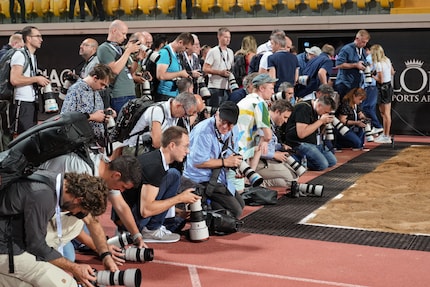
Source: Elisa Hoffmann
Speed and autofocus: out of this world
The timing of the new camera’s no coincidence. Next year, the Summer Olympics will take place in Paris – and the Alpha 9 is Sony’s flagship for sports photography. Thanks to the new global shutter, the camera’s one thing above all: lightning fast. It manages to capture 120 frames per second (FPS). With continuous autofocus. With continuous exposure tracking. In uncompressed RAW format. Without viewfinder blackout.
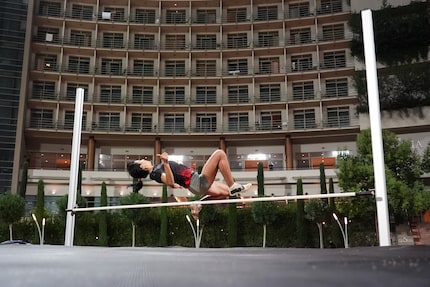
Source: Samuel Buchmann
These values far exceed anything the world’s seen before. And they’re only achievable with an electronic shutter. Until now, this has caused problems when recording very fast movements. As a classic sensor reads the image line by line, this can lead to distortion. A golf club in full swing will look crooked, for example. A global shutter gets rid of this. There’s no distortion, because all pixels are read at the same time. This means Sony can forego a mechanical shutter in the Alpha 9 III.
According to the Japanese manufacturer, the autofocus has also been improved. The AI-supported software recognises limbs and movements. This is designed to calculate where the subject will be in the next moment. In other words, the autofocus tries to predict the future.
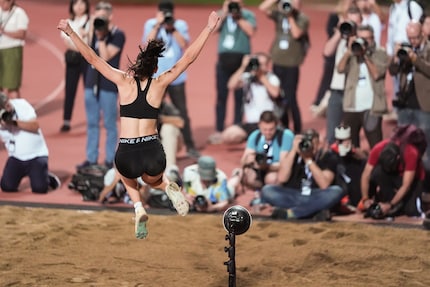
Source: Samuel Buchmann
I’m taking pictures of three sports during Sony’s event: long jump, hurdling and Thai boxing. Dusk has set in, the athletes are illuminated by floodlights. Great conditions for the autofocus, which actually makes almost no mistakes. Even when an athlete runs towards me at full speed, the focus reliably remains on the eyes. The performance of the autofocus is impressive – but I don’t know if the success rate would be lower with the previous model or the Alpha 1.
I usually work with a single focus area, which I can now set to different sizes. If I switch on eye tracking at the same time, the camera searches for the face that’s closest to my focus area – and doesn’t let go of it for as long as I keep that shutter button pressed. This comes in handy when there are several people in the picture, as in Thai boxing.

Source: Samuel Buchmann
The maximum continuous shooting speed of 120 FPS is completely excessive for the three sports I’m testing the camera out with. It would just fill up my memory card in no time. Instead, I set the camera to 30 FPS. By pressing the new C5 button at the front of the camera’s housing on the right, you can still switch to 120 FPS for a short time if you want to. This could be useful if you wanted to catch the exact moment a tennis ball’s compressed by the racket, for example.
What I find particularly nifty is the pre-capture function. When it’s active, the Alpha 9 III continuously saves images before you even press the shutter button. The lead time is 1 second max, which is far too long in most cases. Even at 0.3 seconds, you usually won’t miss anything.
Image quality: what’s the trade-off?
One potential disadvantage of a sensor with a global shutter is poorer image quality. Less resolution, less dynamic range, more image noise.
By today’s standards, the resolution of the Sony Alpha 9 III isn’t particularly high. Its predecessor model already featured 24 megapixels. Cameras including the Nikon Z 9 or the Sony Alpha 1 deliver higher resolutions. This gives you more freedom to crop an image, which is an advantage, especially for wildlife photography. In sports photography, however, high resolution drives data volumes to dizzying heights. So it remains unclear if Sony has deliberately left it at 24 megapixels in the Alpha 9 III, or if this is a consequence of the global shutter.
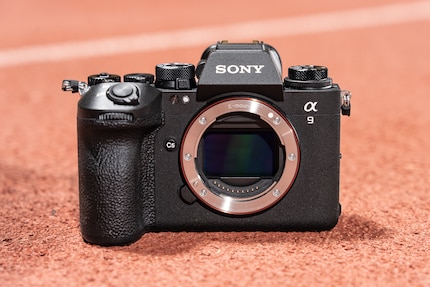
Source: Samuel Buchmann
At ISO 250, the basic sensitivity of the sensor is remarkably high. It’s the only native sensitivity, whereas the predecessor had a dual-gain system. And while Sony usually likes to talk about the dynamic range at presentations, no specific details were provided this time. I’m also still struggling to make a statement myself. Why? Because my test camera wasn’t a final version and the RAW files aren’t yet supported by converters.
My impression of the JPGs: the noise is well under control for those up to ISO 1600. Even images with ISO 6400 should be perfectly fine for most applications – for online or print publications, for example. Things become a bit trickier form ISO 12800. Although cutting-edge noise reduction allows you to save a lot in RAW format these days.

Source: Samuel Buchmann
The dynamic range isn’t noticeable either, at least not in a negative way. It seems, the trade-offs for the global shutter appear to be small. But how good the image quality is compared to other cameras, will only be seen after in-depth testing a final model.
Use and features: unlimited flash
I like that Sony’s made the grip of the Alpha 9 III slightly larger compared to the previous model. It’s more comfortable to hold for my medium-sized hands – even over longer periods of time and with heavy lenses. Sony users will also be familiar with the handling. The buttons are where they always are. What’s new is the additional C5 button at the front on the right. You can assign it according to preference. For example, with the continuous shooting boost.
The electronic viewfinder (EVF) is state of the art. It has the same number of pixels as the Alpha 1 or Alpha 7RV: 9.44 million. But unlike these cameras, the EVF of the Alpha 9 III maintains its resolution at a frame rate of 120 FPS. This makes it so good, I no longer want an optical viewfinder. Not even for sports photography.
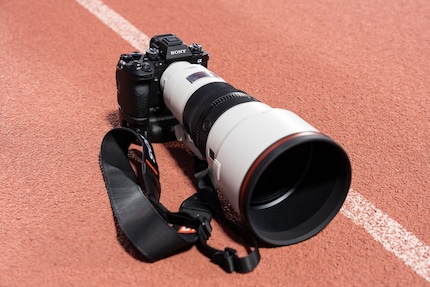
Source: Samuel Buchmann
Another advantage of the global shutter comes into play in flash photography: there’s no limit to the synchronisation time on the camera side. Even at 1/80 000 second, the image is evenly exposed. However, such a short shutter speed doesn’t make sense. After all, flash units also have a bottleneck. The burn-off time at full power is usually longer than 1/1000 of a second. If the sensor’s exposed for a shorter time, it no longer absorbs all the light from the flash tube – the image becomes darker, as if you were shooting with continuous light.
Video: bye-bye distortion
The distortion-free images are a particular advantage in videos. Straight lines don’t warp, not even during fast camera pans. However, I must admit that not even previous stacked sensors, like the one in the Sony Alpha 1, struggled with rolling shutter effects in videos. And even with slower sensors, I can count on one hand the number of times I’ve actually seen distortion in practice.
The Sony Alpha 9 III can film in 4K with up to 120 FPS in 10 bit 4:2:2. Without crop. Up to 60 FPS, this is done using the 6K oversampling method. For anything above that, the subsampling method’s applied. A first test shot looks sharp. But as with the photos, I can’t yet judge the dynamic range and noise behaviour.
Initial conclusion: groundbreaking, but highly specialised
The Sony Alpha 9 III is one of the most important cameras of recent years. The photography world has been waiting for the global shutter for a long time. The fact that the sensor activates all pixels simultaneously eliminates the main problem of classic shutters – the rolling shutter effect. In flash photography, the global shutter also eliminates the synchronisation time bottleneck.
Tests with final models will reveal whether there are any compromises in picture quality. At least I didn’t notice any at first glance. The global shutter is likely to make its way into many cameras in the future – after all, Sony supplies all major manufacturers except for Canon with its sensors. However, it will be a few years before the technology is featured in affordable models.
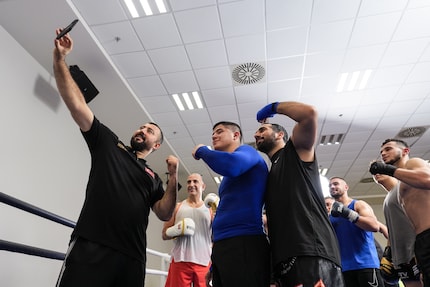
Source: Samuel Buchmann
Aside from this groundbreaking function, the global shutter makes the Sony Alpha 9 III incredibly fast. 120 RAW images per second with continuous autofocus and no viewfinder blackout is unheard of. Focus tracking is also impressively reliable, although other cameras are also good at this.
In practice, however, only professional sports photographers will begin to make use of the speed of the new flagship. For everyone else, the huge price tag can’t be justified. Wildlife photographers are probably also better off using other models. This makes the Sony Alpha 9 III a pioneering but highly specialised camera.
Header image: Klaus Lorbeer
My fingerprint often changes so drastically that my MacBook doesn't recognise it anymore. The reason? If I'm not clinging to a monitor or camera, I'm probably clinging to a rockface by the tips of my fingers.


